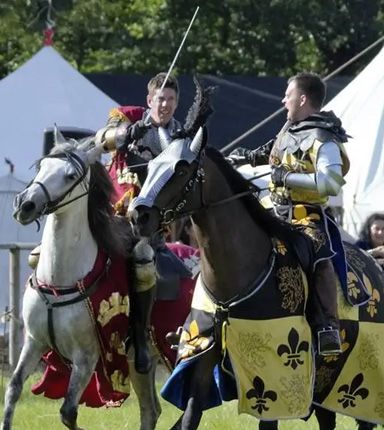
The Norman conquest
The Normans won the Battle of Hastings, but was it all fun and games from then on? Imagine having to move to a new country, learn a new language, and all the while worry about whether the English peasants were looking to kill you in your sleep! How do you even know what you are ruling over? Perhaps you should take a survey of everything and everyone in the land. You could call it the Domesday Book and it would contain everything in the country down to the last sheep. Once you’re settled in your new land, make sure the peasants aren’t revolting, your castle is in good repair and the Lord next door hasn’t got his eye on your lands. Better make sure you keep in favour with the king…but which king?! They’re always fighting over the throne so it’s hard to know who to back. Some are OK but some are pretty mean and want to take all your money to fight their personal wars! You could help the other Barons get power back from the King, or maybe you should just go on holiday. There are these things called Crusades going on down in the Holy Land… but make sure you’re feeling fit because you’ll have to walk all the way!
kings and crusades
This was the age of some of our most famous Kings: William the Conqueror, Richard the Lionheart, King John, Henry V and Richard III. The Barons made King John sign the Magna Carta in 1215, removing the King’s right to raise taxes and impose laws without the agreement of a council of Barons. Although the charter itself was quickly altered and superseded, this council would eventually become the parliament we still have today.
The middle ages were also a time of crusades and trades, of the Knights Templar and the legends of King Arthur and Robin Hood. Travels to the Holy Lands brought back more than religious satisfaction however, and luxury goods like sugar and spices became more widely available. Map making became an art and the first maps of the known World (Europe and Asia) were drawn. Expeditions by sea and land “discovered” far off places like China and the Mongolian Empire expanded as far as Eastern Europe.


out with the old and in with the middle
It was a time of knights and castles, princesses and dragons, romantic literature and civil war. The Royal Family was now French! English nobles lost their estates to Norman families and the English people became the peasant class. The feudal system was introduced by the Normans, keeping society in a strictly controlled class system and making sure the rich got richer whilst the poor stayed poor. We even got a new language! Middle English was a mish-mash of Old English, Norman French and a little Old Norse mixed in, and almost unrecognisable from the Old English spoken by the Anglo Saxons. Rebellions against the Normans were swiftly put down and the north of England was laid to waste so thoroughly that large regions would take decades to recover. Many of the castles that still dot the British landscape today were built by the Normans and their descendants to remind the locals just who was in charge!
The black death
In the 1340s the Black Death swept through Europe from Asia causing the death of almost half the population, and towns and villages lay deserted and disappearing under untended fields. Peasants rebelled against the ruling classes, realising their labour was in short supply and should no longer come cheap. Unpopular tax rises to fund foreign wars tipped the balance and the common folk marched on London, breaking into the Tower of London and killing the Lord Chancellor and Lord High Treasurer. Although the rebellion was eventually put down, Kings were far more careful about raising taxes for wars after that!


Wars of the Roses
Surprisingly nothing to do with gardening, this was the Houses of Lancaster (whose symbol was the red rose) and York (the white rose) fighting over the throne of England. Following the death of Henry V of dysentery, his infant son Henry VI was crowned King at just nine months old. Henry was not a warlike king and eventually succumbed to mental illness, prompting a bloody civil war between rival claimants to the throne. He ended his days a prisoner of the Yorkists in the Tower of London.
The House of York gave Britain one of its most notorious kings: King Richard III. Shakespeare wrote a play about him, portraying him as a ruthless leader willing to do anything to get the throne, including orchestrating the murder of his nephews, the Princes in the Tower. Richard was eventually defeated by Henry Tudor on the battlefield of Bosworth, Leicestershire in 1485, after which the House of Tudor took the throne.


Leave a Reply
You must be logged in to post a comment.